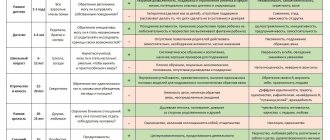More useful information about other various types of diseases starting with the letter “M”: Lesser chorea, Slow infections of the central nervous system, Medulloblastoma, Herniated disc, Thoracic disc herniation, Lumbar disc herniation, Cervical disc herniation, Intercostal neuralgia, Meningeal syndrome, Meningioma, Meningitis , Meningococcal meningitis, Meningomyelitis, Meningoencephalitis, Metabolic myopathy, Metastatic brain tumors, Metachromatic leukodystrophy, Weather sensitivity, Myasthenia gravis, Migraine stroke.
Meningeal syndrome: concept
Meningeal syndrome (MS) is a symptomatic complex that occurs when there are abnormalities in the cerebral surfaces. The presented disease can manifest itself when infectious microorganisms enter the body, intoxication with chemicals, problems with blood vessels, diseases of a liquor-hypertensive nature, damage and anomalies of carcinomatous etiology. The main factors characteristic of MS are the presence of pain in the head, muscle rigidity, gag reflexes, hyperesthesia and algic phenomena.
The basis of the research is clinical indicators and reports after analysis of the spinal substance. The treatment plan is based on the etiology of occurrence. Mostly doctors prescribe medications that have antiviral, antifungal, and antiprotozoal effects. In addition, symptomatic relief and stabilization of intracranial pressure are prescribed.
brief information
Meningeal disorder is a common disease that occurs quite often in the practice of doctors in the field of neurology, pediatrics, otolaryngology and other specializations. Translated from Latin, the name of the pathology means “brain membrane.” There is a type of MS when irritation of the cerebral cavity occurs without inflammatory processes; it is called in medical practice - meningism.
A large number of discoveries, information and rare facts were made back in the 19th century. The disease was studied by many scientists around the world, who eventually offered specific descriptions of the symptoms of the disease. The concepts are currently in use. One of the nuances of a neurological disorder is the inaccurate clinical picture of the disorder in the retirement age population.
Causative agents of meningeal syndrome
Intracranial disorders and multisystem anomalies become harmful causes. Often, MS provokes the progress of the inflammatory process occurring in the brain structures (meningitis), subarachnoid bleeding, and head injury. In accordance with the effect on the cerebral membranes, etiological sources are divided into two categories: inflammatory and non-inflammatory.
First group:
- Bacterial origin: nonspecific (caused by the entry into the body of meningococcal infection, Haemophilus influenzae, pneumococci, and in infants - Escherichia coli and salmonella), specific (begins when pathogenic elements of tuberculosis and syphilis appear in the departments).
- Viral origin - in almost 75% of diagnosed cases, they develop with the participation of enteroviruses, in rare situations - adenovirus, herpetic infection, tick-borne encephalitis, etc. The main factors are microorganisms of cryptococcal, candida, and histoplasmic nature (provoking severe inflammatory foci with petechial hemorrhage).
- Protozoal origin - the main sources are toxoplasmosis and malaria.
Second group:
- A large accumulation of blood cells in the brain structures (appear as a result of an acute malfunction in the circulatory system, severe arterial hypertension, skull injuries, cerebral vasculitis).
- Intracranial hypertension is a consequence of hydrocephalus, neoplasms (formation of a malignant or benign tumor, intracranial cyst, abscess, hematoma).
- Poisoning: exogenous type - paints and varnishes are provocateurs, bad habits such as substance abuse or alcohol addiction, endogenous type - uremia, hypoparathyroidism are considered causative agents.
- Neurotoxic origin in general infections - seasonal influenza, dysentery, colds, etc.
- Carcinomatous origin - complications after infiltration of the cerebral membranes by cancer cells during cancer processes (including the leukocyte type of infiltration in neurolecosis disease).
Consequences
Severe consequences of meningitis are more often recorded in young children and with delayed treatment.
If the diagnosis is not made on time and therapy is delayed, dangerous complications develop: sepsis, endocarditis, pneumonia, abscess or cerebral edema.
The most common consequences of meningitis suffered in childhood:
- hydrocephalus;
- mental retardation;
- epileptic seizures;
- paresis;
- decreased or loss of hearing;
- damage to the cranial nerves.
Even with a successful outcome, after discharge the child experiences asthenoneurotic conditions: sleep disturbance, anxiety, headaches, memory loss, fatigue.
Development mechanism
In medical practice, there are two types of disease progression: inflammatory and pathogenetic. VP begins when an infection enters the body. Infection of the brain elements occurs in several ways: contact, lymphogenous, perineural and hematogenous. The lesion can be transmitted through blood if the patient has purulent foci. If encephalitis progresses, the harmful anomaly spreads to the soft tissues and causes the development of meningoencephalitis. The pathogenetic mechanism of the flow causes irritation of the cerebral parts. The causative agents are:
- Blood collections during bleeding.
- High surges in intracranial pressure.
- Entry into the body of toxic components (external and formed during dysmetabolic actions).
- Vital activity of negative cells.
- Tissue breakdown during cancer progression.
Prevention measures
Prevention of meningitis depends on the etiology. Patients are urgently hospitalized and isolated. Persons in contact with the sick person are examined for carriage and observed for 10 days.
To prevent a dangerous disease, immunization is carried out. There are several vaccines, both foreign and Russian. For example, the imported vaccine against pneumococcal meningitis “Prevenar” is approved for children from 3 months of age. Well tolerated and does not cause side effects. After completing the full course of vaccination, by the age of two years the child develops stable immunity.
Vaccinations against meningococcal infection are carried out with the Russian vaccine from 1.5 years, and the American vaccine from 2 years.
Vaccination is not included in the scheduled vaccination calendar; it is carried out according to indications or at the personal request of the parents.
Symptoms of meningeal syndrome
The symptom complex consists of general cerebral phenomena and meningeal problems. Characteristic clinical manifestations are:
- Diffuse cephalalgia (pain in the head area).
- Vomiting reflexes that are not accompanied by nausea, without making the patient feel better.
- Excited behavior followed by apathetic behavior.
- Seizures.
- The appearance of hallucinations.
- Depression of thinking and consciousness until the patient completely switches off (stupor, coma).
In addition, meningeal syndrome is complemented by pathognomonic symptoms, divided by experts into three main groups:
- Painful phenomena.
- Manifestations of a muscular-tonic nature are an unstable state of muscle tissue.
- Complaints accompanying hyperesthesia - a person develops a high intolerance to noise, light and touch.
Two cases from practice
An example is the case history of a patient with Anton-Babinski syndrome, described by Danish neurologists Daniel Kondziella and Siska Fram-Falkenberg.
“A 55-year-old man, after 3 weeks of fever and night sweats, began to behave very strangely. He bumped into tables and chairs, could not find the cup standing right in front of him, recognized friends and relatives only when they spoke to him. Despite the fact that he had clearly lost his sight and could not cope with everyday activities on his own, he did not admit it. He denied his blindness and, encountering obstacles, came up with harmless excuses for this. If he was asked questions about the appearance of something, he did not hesitate to make something up.
The patient was diagnosed with infective endocarditis - transesophageal echocardiography revealed vegetations on the aortic valve. The selection of antibiotics has begun. A CT scan of the brain revealed extensive infarction of both occipital lobes and white matter of the left parietal lobe. No recurrent episodes of embolism were observed after installation of the aortic valve prosthesis. After surgery, the patient gradually began to realize that he was blind, but still remained indifferent to this fact. Despite a long rehabilitation program, I was never able to return to independent life.”
From a survey of a patient with Anton-Babinski syndrome.
Doctor:
How do you feel?
Patient:
Normal.
Doctor:
Are you okay?
Patient:
Yes, everything is fine.
Doctor:
What about your vision?
Patient:
Everything is fine.
Doctor (showing a pen):
Tell me, what is this?
Patient:
Doctor, it's too dark in here.
Nobody sees anything. Doctor (turning on the electric light, despite the fact that it is light outside):
I turned on the light.
Now can you tell what it is? Patient:
Listen, I don’t want to play these games with you.
Doctor (tall and thin):
Okay.
Can you describe my appearance? Patient:
Of course. You are so small and fat [2].
The famous British neurologist, neuropsychologist and publicist Oliver Sacks, in his book “The Man Who Mistook His Wife for a Hat” (1971), uses examples from his patients to describe several types of anosognosia. Here, for example, is an excerpt from the story “To the Right, Around!”, which describes the life of Mrs. S., a sixty-year-old woman who suffered a massive stroke:
“Mrs. S. has irrevocably lost the idea of \u200b\u200bthe “left side” - both in relation to the world and in relation to her own body. Sometimes she grumbles that her portions are too small, but this is because she only takes food from the right side of the plate. It doesn’t even occur to her that the plate has a left half. Having decided to tidy up her appearance, she paints her lips and applies powder only to the right side, and does not touch the left side of her face at all. It is almost impossible to help her here, since there is no way to attract her attention to the right place. Intellectually, of course, she understands that something is wrong, and sometimes she even laughs at it, but she has no direct knowledge.
Intellect and deduction come to her aid. She developed various strategies to circumvent the defect. Unable to look and turn to the left, she turns to the right. To do this, she ordered a swivel wheelchair and now, if she doesn’t find something in the right place, she spins clockwise until the thing she’s looking for is in sight. If it seems to her that there is not enough food on her plate, she also begins to spin to the right. Having reached the missing half in a circle, she eats it, or rather half of this amount, and thus satisfies her hunger. […]
It would seem that it is much easier to turn the plate than to rotate itself. She also thinks so and says that she has already tried it, but has encountered strange internal resistance. It turned out that it was much easier and more natural for her to spin around in her chair, since all her attention, all her movements and impulses were now instinctively directed to the right and only to the right.”
Diagnostic options
The patient is accompanied at all stages of examination and further treatment by doctors specializing in problems of infectious origin, a pediatrician, and experts in the field of neurology and therapy. During a visit to the healthcare provider's office, the patient undergoes a standard examination for the presence of characteristic body position, hyperesthesia, pain and tonic phenomena. There are over 30 types of clinical manifestations of complaints that effectively help identify membrane disease. The following are widely used:
- Kernig's sign - the patient assumes a supine position and passively bends his legs.
- Brudzinski's symptoms - in the same position, the doctor palpates the pubis, as a result of which the lower limbs spontaneously pull towards the abdominal cavity.
- Edelman's sign - you need to straighten the big toe when testing using the Kurnig method.
The main role in diagnosing MS is played by lumbar puncture. However, it cannot be done in cases of pronounced hypertension or the likelihood of a mass effect. Such a study can be prescribed only after obtaining information from an ophthalmoscopic analysis and an EEG. Doctors prescribe checking the cerebral substance, blood cells, bacteriological and virological assessment of the cerebrospinal fluid, blood culture, PCR examination and MRI scan of the brain.
Treatment options
The severe stage of MS can only be treated therapeutically in a hospital setting:
- Pharmacological substances of a broad spectrum antibiotic therapy, antiviral and antimycotics are prescribed.
- Detoxification is performed to eliminate the main provocateur.
- Taking diuretics and glucocorticosteroid medications.
- Use of antipyretics, antihypertensive drugs and antiemetic pharmaceuticals.
- Anticonvulsants are prescribed.
Further forecast
If you consult a neurologist or therapist in a timely manner, there is a high probability of a rapid recovery of the patient with MS. Doctors report that residual signs of the disease may appear for several months:
- Chronic fatigue syndrome.
- Emotional instability.
- Headache.
- Increased intracranial pressure.
An unfavorable prognosis can only occur in the case of a course of the disease accompanied by serious pathology of the central nervous system, ultra-rapid development of infectious lesions and oncology.
Preventive actions
To prevent the occurrence of meningeal syndrome, you should adhere to the following rules:
- Monitor the level of your immune system.
- During the prevention of infectious diseases.
- Avoid injury and poisoning.
- Promptly contact a specialist in case of cerebrovascular anomalies and cardiovascular diseases.
Specific preventive actions may be relevant for infectious microorganisms that cause meningococcus and pneumococcus.
Treatment
If meningitis is suspected, urgent hospitalization to the infectious diseases department is indicated.
For bacterial meningitis, treatment includes:
- antibacterial therapy;
- anticonvulsants;
- non-steroidal anti-inflammatory drugs;
- detoxification therapy;
- antihistamines;
- corticosteroid hormones.
Treatment of meningitis of viral etiology does not require antibiotics. Recombinant interferon, acyclovir, and immunomodulators are used. Infusion and desensitizing therapy are also carried out. After receiving the results of bacteriological culture, therapy is adjusted depending on the pathogen.
The duration of treatment depends on the clinical course of the infection. For meningococcal meningitis, antibiotic therapy lasts 6-10 days, for other etiologies 8-14 days. Treatment begins with intravenous administration of antibiotics and continues until the temperature drops persistently, then switches to oral administration or intramuscular injections of drugs.











